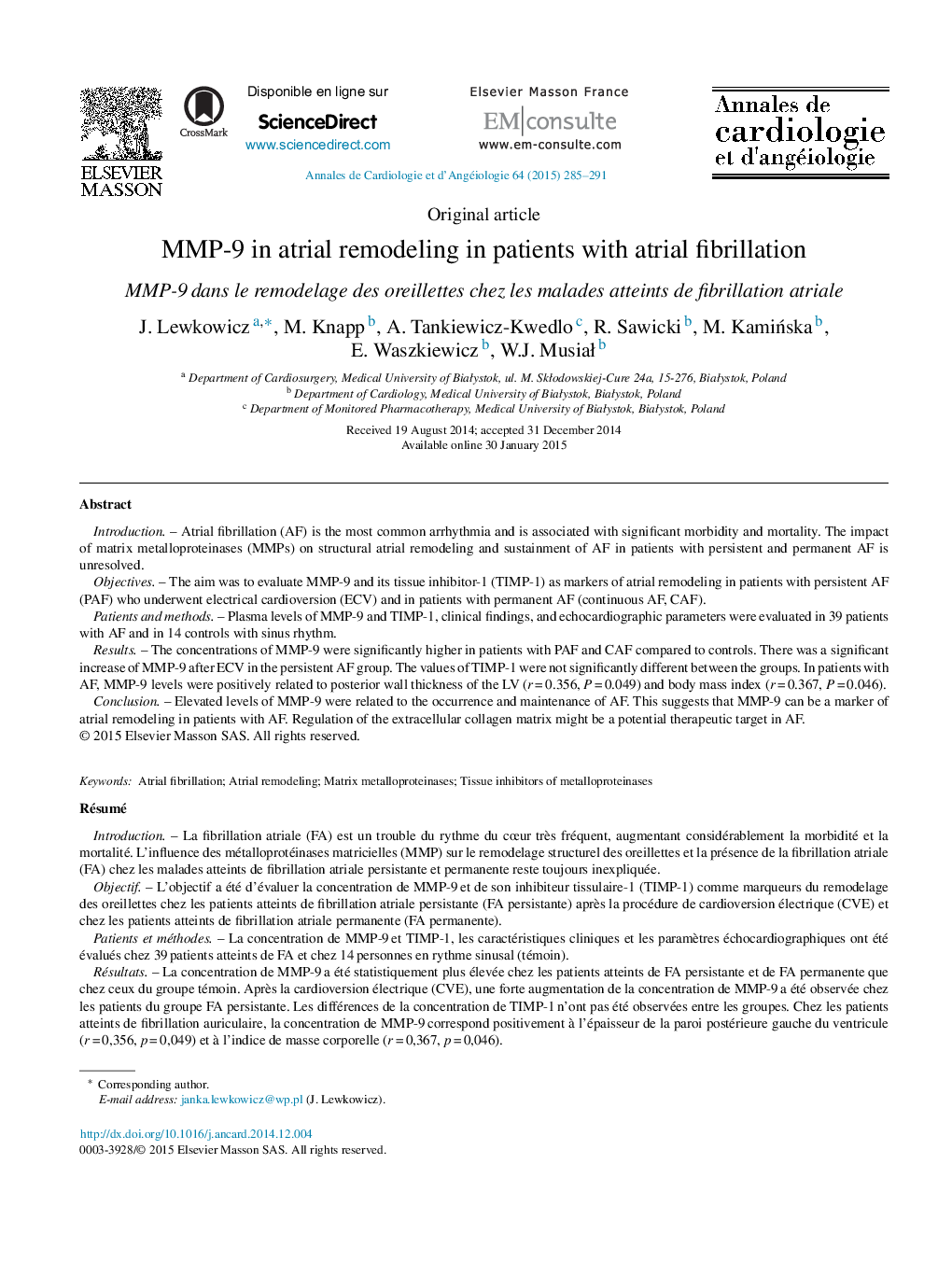| Article ID | Journal | Published Year | Pages | File Type |
|---|---|---|---|---|
| 2868525 | Annales de Cardiologie et d'Angéiologie | 2015 | 7 Pages |
IntroductionAtrial fibrillation (AF) is the most common arrhythmia and is associated with significant morbidity and mortality. The impact of matrix metalloproteinases (MMPs) on structural atrial remodeling and sustainment of AF in patients with persistent and permanent AF is unresolved.ObjectivesThe aim was to evaluate MMP-9 and its tissue inhibitor-1 (TIMP-1) as markers of atrial remodeling in patients with persistent AF (PAF) who underwent electrical cardioversion (ECV) and in patients with permanent AF (continuous AF, CAF).Patients and methodsPlasma levels of MMP-9 and TIMP-1, clinical findings, and echocardiographic parameters were evaluated in 39 patients with AF and in 14 controls with sinus rhythm.ResultsThe concentrations of MMP-9 were significantly higher in patients with PAF and CAF compared to controls. There was a significant increase of MMP-9 after ECV in the persistent AF group. The values of TIMP-1 were not significantly different between the groups. In patients with AF, MMP-9 levels were positively related to posterior wall thickness of the LV (r = 0.356, P = 0.049) and body mass index (r = 0.367, P = 0.046).ConclusionElevated levels of MMP-9 were related to the occurrence and maintenance of AF. This suggests that MMP-9 can be a marker of atrial remodeling in patients with AF. Regulation of the extracellular collagen matrix might be a potential therapeutic target in AF.
RésuméIntroductionLa fibrillation atriale (FA) est un trouble du rythme du cœur très fréquent, augmentant considérablement la morbidité et la mortalité. L’influence des métalloprotéinases matricielles (MMP) sur le remodelage structurel des oreillettes et la présence de la fibrillation atriale (FA) chez les malades atteints de fibrillation atriale persistante et permanente reste toujours inexpliquée.ObjectifL’objectif a été d’évaluer la concentration de MMP-9 et de son inhibiteur tissulaire-1 (TIMP-1) comme marqueurs du remodelage des oreillettes chez les patients atteints de fibrillation atriale persistante (FA persistante) après la procédure de cardioversion électrique (CVE) et chez les patients atteints de fibrillation atriale permanente (FA permanente).Patients et méthodesLa concentration de MMP-9 et TIMP-1, les caractéristiques cliniques et les paramètres échocardiographiques ont été évalués chez 39 patients atteints de FA et chez 14 personnes en rythme sinusal (témoin).RésultatsLa concentration de MMP-9 a été statistiquement plus élevée chez les patients atteints de FA persistante et de FA permanente que chez ceux du groupe témoin. Après la cardioversion électrique (CVE), une forte augmentation de la concentration de MMP-9 a été observée chez les patients du groupe FA persistante. Les différences de la concentration de TIMP-1 n’ont pas été observées entre les groupes. Chez les patients atteints de fibrillation auriculaire, la concentration de MMP-9 correspond positivement à l’épaisseur de la paroi postérieure gauche du ventricule (r = 0,356, p = 0,049) et à l’indice de masse corporelle (r = 0,367, p = 0,046).ConclusionL’augmentation de la concentration de MMP-9 a été associée à la survenue et la présence de FA. Il en résulte que MMP-9 peut être considéré comme marqueur du remodelage des oreillettes chez les patients souffrant d’arythmie. La régulation de l’activité des enzymes de la matrice extracellulaire peut avoir des objectifs thérapeutiques potentiels.
